
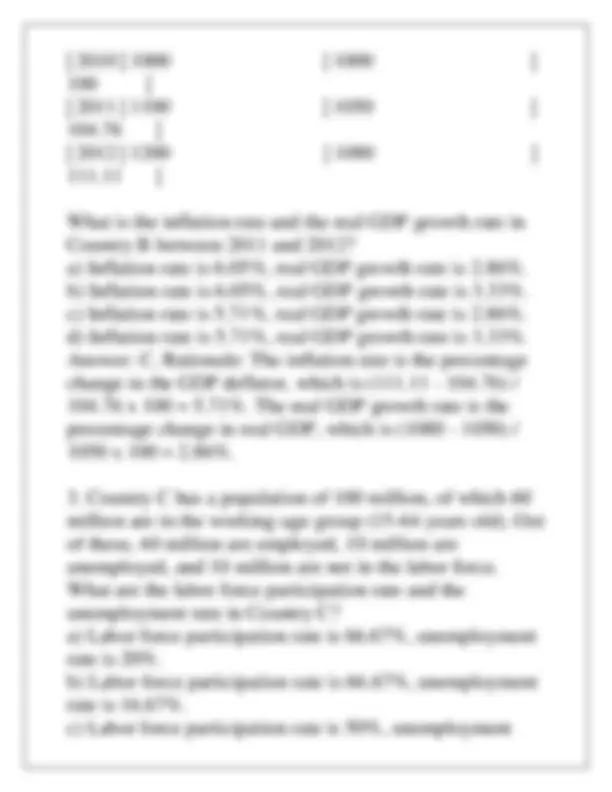
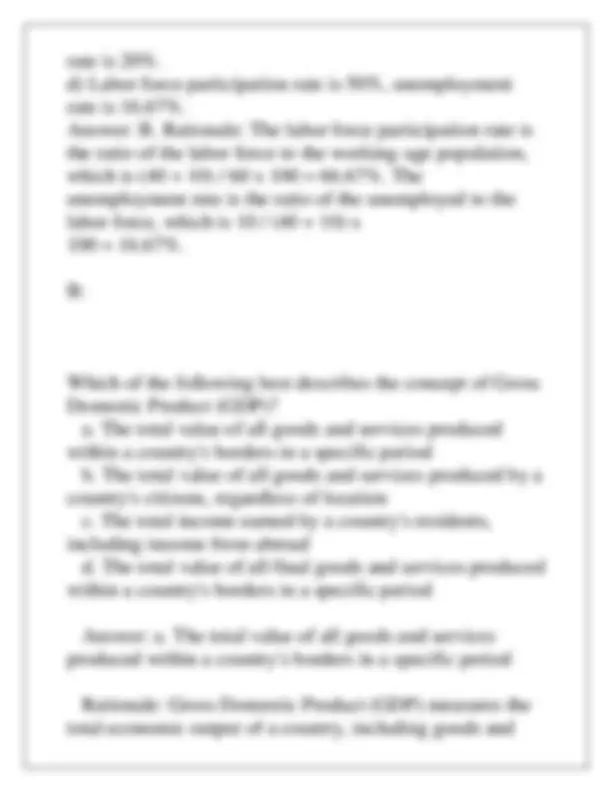
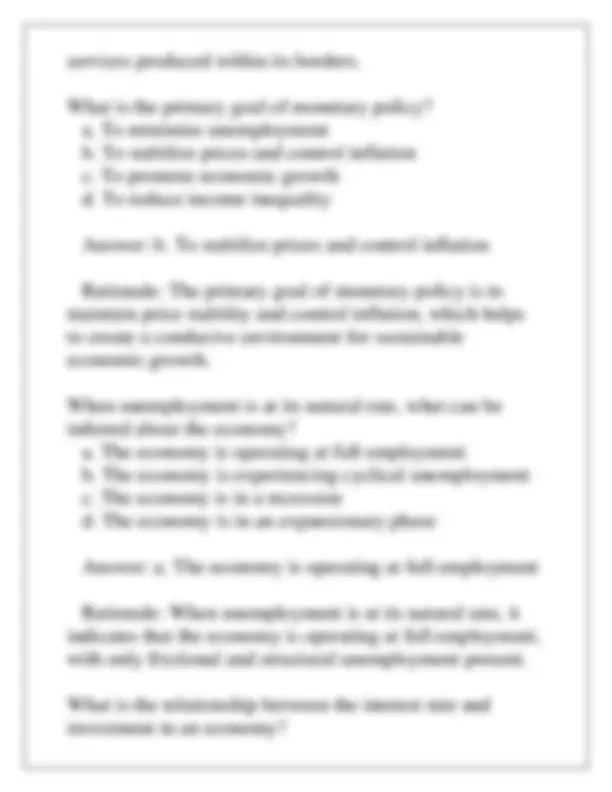
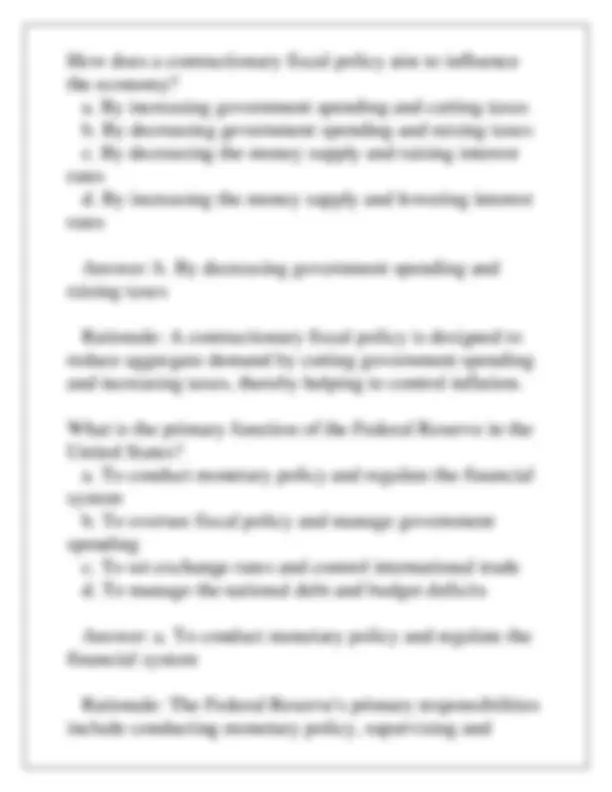
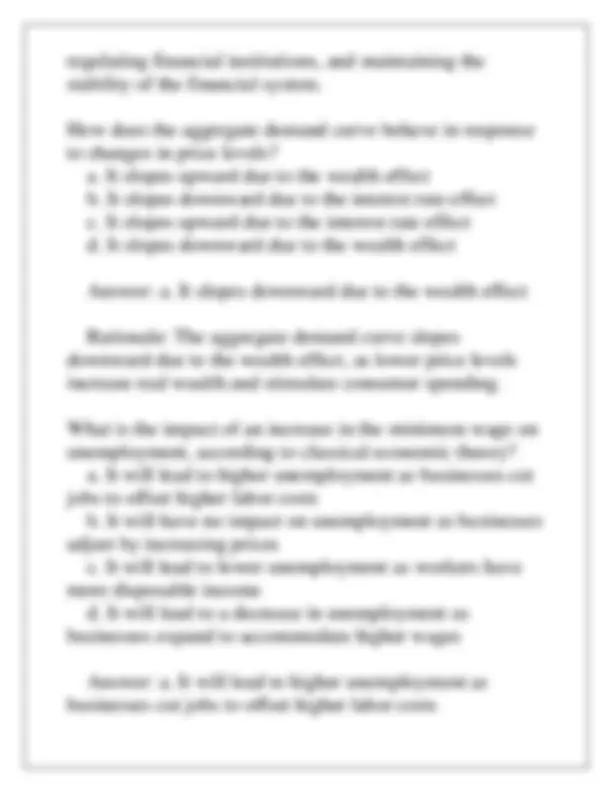
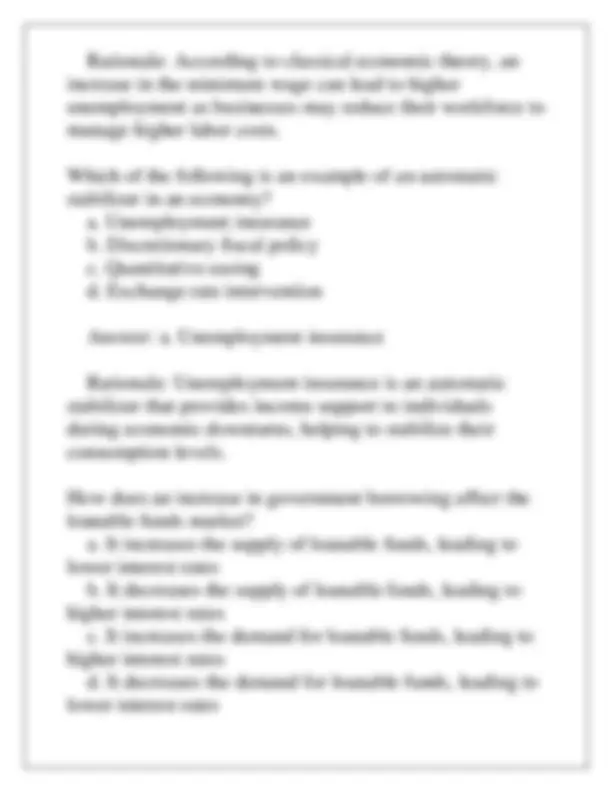
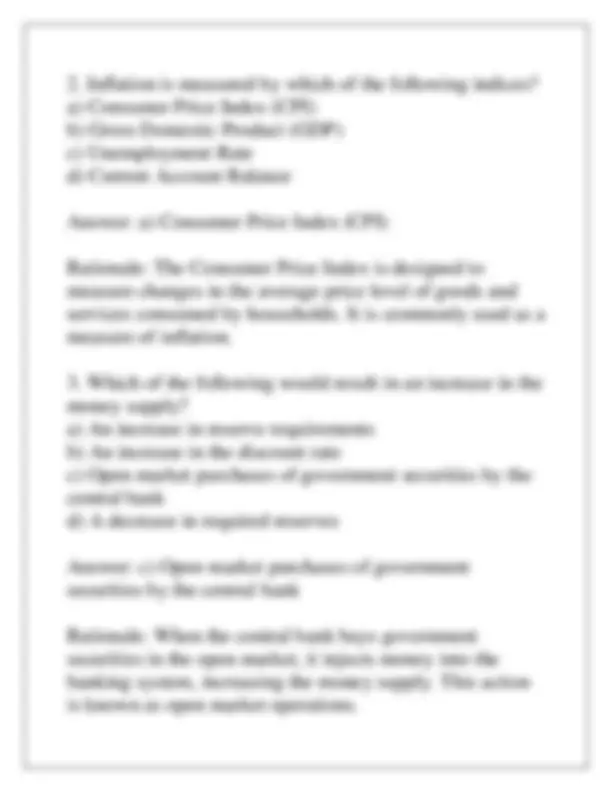
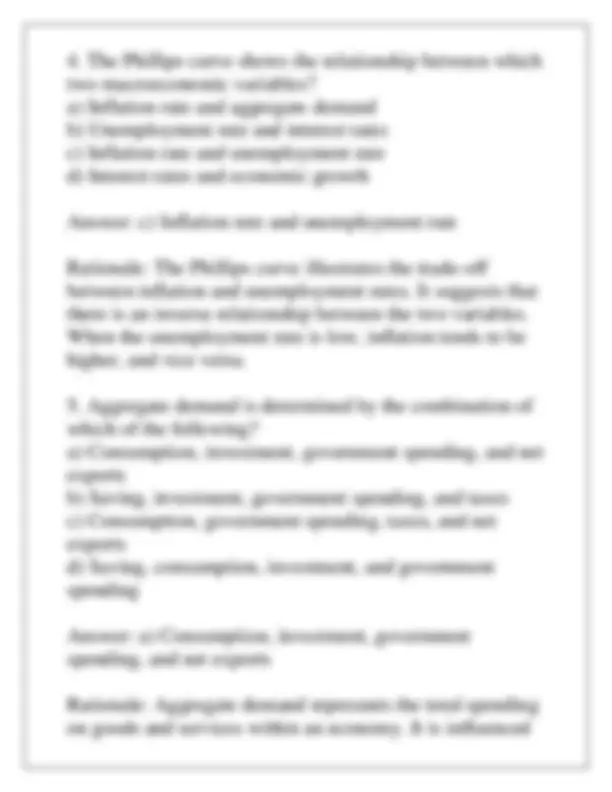
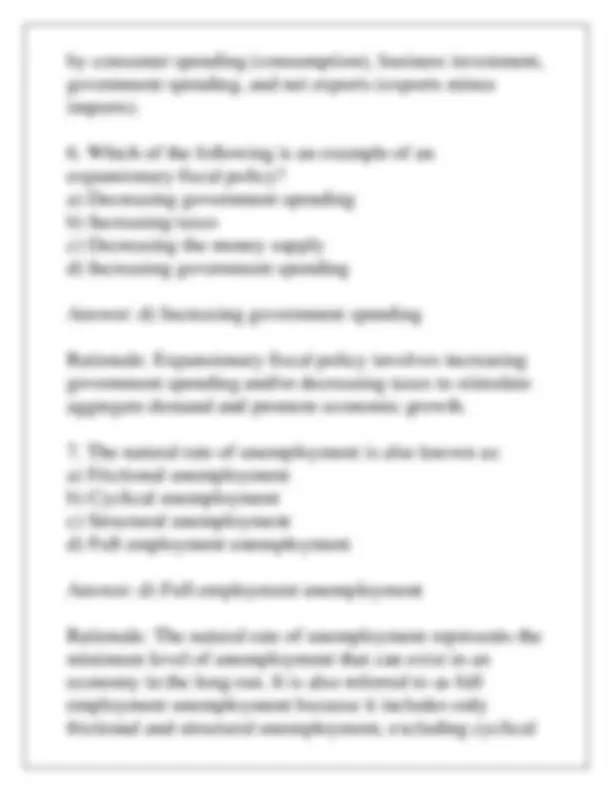

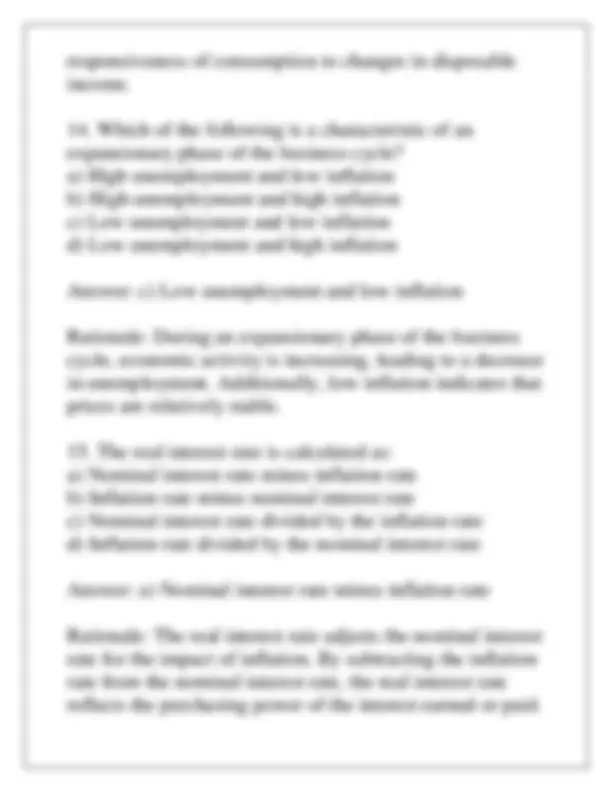


Study with the several resources on Docsity

Earn points by helping other students or get them with a premium plan


Prepare for your exams
Study with the several resources on Docsity

Earn points to download
Earn points by helping other students or get them with a premium plan
Community
Ask the community for help and clear up your study doubts
Discover the best universities in your country according to Docsity users
Free resources
Download our free guides on studying techniques, anxiety management strategies, and thesis advice from Docsity tutors
A set of questions and answers with rationales related to macroeconomics principles. The questions cover topics such as fiscal and monetary policy, trade, inflation, unemployment, and GDP. The answers provide explanations and reasoning behind the correct option. useful for students studying macroeconomics who want to test their knowledge and understanding of the subject.
Typology: Exams
1 / 19

This page cannot be seen from the preview
Don't miss anything!












rate is 20%. d) Labor force participation rate is 50%, unemployment rate is 16.67%. Answer: B. Rationale: The labor force participation rate is the ratio of the labor force to the working-age population, which is (40 + 10) / 60 x 100 = 66.67%. The unemployment rate is the ratio of the unemployed to the labor force, which is 10 / (40 + 10) x 100 = 16.67%. B: Which of the following best describes the concept of Gross Domestic Product (GDP)? a. The total value of all goods and services produced within a country's borders in a specific period b. The total value of all goods and services produced by a country's citizens, regardless of location c. The total income earned by a country's residents, including income from abroad d. The total value of all final goods and services produced within a country's borders in a specific period Answer: a. The total value of all goods and services produced within a country's borders in a specific period Rationale: Gross Domestic Product (GDP) measures the total economic output of a country, including goods and
services produced within its borders. What is the primary goal of monetary policy? a. To minimize unemployment b. To stabilize prices and control inflation c. To promote economic growth d. To reduce income inequality Answer: b. To stabilize prices and control inflation Rationale: The primary goal of monetary policy is to maintain price stability and control inflation, which helps to create a conducive environment for sustainable economic growth. When unemployment is at its natural rate, what can be inferred about the economy? a. The economy is operating at full employment b. The economy is experiencing cyclical unemployment c. The economy is in a recession d. The economy is in an expansionary phase Answer: a. The economy is operating at full employment Rationale: When unemployment is at its natural rate, it indicates that the economy is operating at full employment, with only frictional and structural unemployment present. What is the relationship between the interest rate and investment in an economy?
surplus indicate for a country? a. The country is exporting more goods and services than it is importing b. The country is importing more goods and services than it is exporting c. The country has a negative balance of trade d. The country's currency is overvalued Answer: a. The country is exporting more goods and services than it is importing Rationale: A trade surplus occurs when a country's exports exceed its imports, indicating a positive balance of trade. What is the Phillips curve used to illustrate in macroeconomics? a. The relationship between inflation and unemployment b. The impact of government budget deficits on economic growth c. The relationship between interest rates and investment d. The influence of exchange rates on international trade Answer: a. The relationship between inflation and unemployment Rationale: The Phillips curve demonstrates the inverse relationship between inflation and unemployment in an economy.
How does a contractionary fiscal policy aim to influence the economy? a. By increasing government spending and cutting taxes b. By decreasing government spending and raising taxes c. By decreasing the money supply and raising interest rates d. By increasing the money supply and lowering interest rates Answer: b. By decreasing government spending and raising taxes Rationale: A contractionary fiscal policy is designed to reduce aggregate demand by cutting government spending and increasing taxes, thereby helping to control inflation. What is the primary function of the Federal Reserve in the United States? a. To conduct monetary policy and regulate the financial system b. To oversee fiscal policy and manage government spending c. To set exchange rates and control international trade d. To manage the national debt and budget deficits Answer: a. To conduct monetary policy and regulate the financial system Rationale: The Federal Reserve's primary responsibilities include conducting monetary policy, supervising and
Rationale: According to classical economic theory, an increase in the minimum wage can lead to higher unemployment as businesses may reduce their workforce to manage higher labor costs. Which of the following is an example of an automatic stabilizer in an economy? a. Unemployment insurance b. Discretionary fiscal policy c. Quantitative easing d. Exchange rate intervention Answer: a. Unemployment insurance Rationale: Unemployment insurance is an automatic stabilizer that provides income support to individuals during economic downturns, helping to stabilize their consumption levels. How does an increase in government borrowing affect the loanable funds market? a. It increases the supply of loanable funds, leading to lower interest rates b. It decreases the supply of loanable funds, leading to higher interest rates c. It increases the demand for loanable funds, leading to higher interest rates d. It decreases the demand for loanable funds, leading to lower interest rates
Answer: b. It decreases the supply of loanable funds, leading to higher interest rates Rationale: An increase in government borrowing reduces the supply of loanable funds, putting upward pressure on interest rates in the loanable funds market. What is the impact of a depreciation of the domestic currency on a country's balance of trade? a. It will lead to a trade surplus as exports become cheaper for foreign buyers b. It will lead to a trade deficit as imports become more expensive for domestic buyers c. It will have no impact on the balance of trade d. It will lead to a decrease in the country's foreign exchange reserves Answer: a. It will lead to a trade surplus as exports become cheaper for foreign buyers Rationale: A depreciation of the domestic currency makes exports cheaper for foreign buyers, leading to increased export competitiveness and a potential trade surplus. How does a supply-side policy aimed at reducing business regulations impact long-term economic growth? a. It accelerates long-term economic growth by fostering innovation and entrepreneurship b. It hinders long-term economic growth by creating
unemployment.
country is purchasing more goods and services from abroad than it is selling, leading to a negative trade balance.
responsiveness of consumption to changes in disposable income.